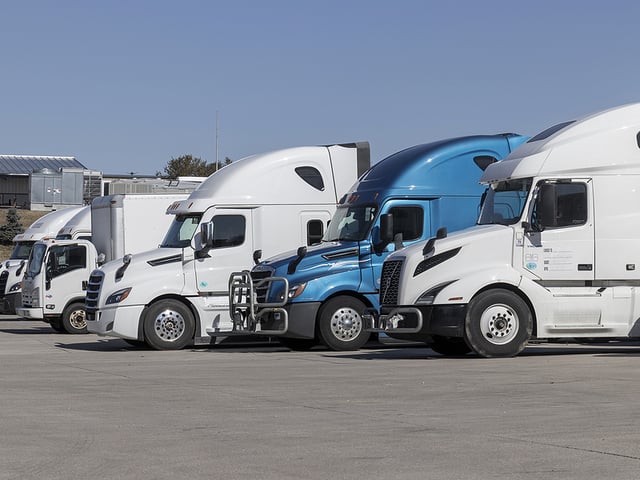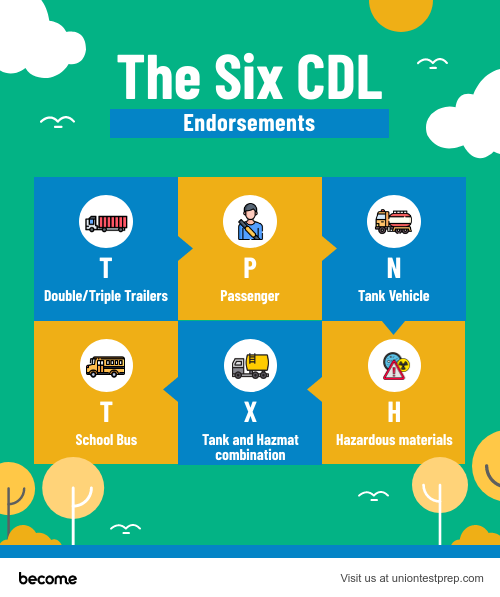
The CDL Manual by State: Everything You Need to Know
Are you ready to average over $81,997 per year with numerous career and employment benefits? Then it’s time to start working on a Commercial Driver’s License (CDL).
A CDL allows you to drive commercial trucks, buses, and other assorted large vehicles. The licensing process is straightforward, but it’s also very exact with the highest safety and professional standards in mind.
You’ll have to meet national CDL requirements, and successfully complete your state’s testing and training programs. Our guide has all the general information you need, along with links to every CDL manual by state so you can look up your resident-specific requirements.
National CDL Requirements
Federal guidelines are a baseline every state must meet. There are no states that allow 17-year-olds to hold a CDL, for example, because the national age requirement is a minimum of 18 years old.
Other requirements include:
-
A valid driver’s license (non-commercial)
-
1-2 years driving experience
-
Proof of citizenship or lawful residency
-
Medical certification
-
Cleared background check
-
English language proficiency (CDL tests are English-only)
-
Driver’s license history
-
Proof of state residency
-
Knowledge and skills test
The knowledge and skills test will be administered by your state licensing office. Drivers must also complete the training programs through the state.
The Federal Motor Carrier Safety Administration (FMSCA) maintains an official registry of approved training providers. A provider must have FMSCA approval for their training program to be valid.
Additionally, drivers must be at least 21 years of age to:
-
Drive across state lines (interstate travel)
-
Hold a hazardous material (hazmat) endorsement
Drivers with a hazmat endorsement must also:
-
Pass the hazmat knowledge exam
-
Pass the Transportation Security Administration (TSA) security threat assessment
-
Submit their fingerprints to the official database
These basic requirements are just the first step. You can still be disqualified based on certain factors. You may also face state standards that are stricter than federal minimums.
National CDL Disqualifications
Disqualifying factors can prevent you from applying for a CDL license. They can also result in suspension/permanent revocation once you have your license.
To keep yourself and other drivers safe on the road, you must pass DoT’s medical qualifications. The medical certification process will examine your:
-
Vision
-
Hearing
-
Blood pressure
-
Blood sugar
-
Misc. major health concerns (diabetes, seizures, limb loss, drug/alcohol abuse, etc.)
Some medical issues may be conditionally approved/disapproved. This depends on the issue’s severity and the management options. Other conditions can result in an automatic disqualification.
Unlawful behavior is another disqualifier, particularly if it pertains to driving:
-
Using a vehicle to commit felony drug trafficking
-
Any human trafficking conviction
-
Major traffic violations (DUIs, fleeing the scene, negligent driving fatality, etc.)
-
Serious traffic violations (excess speed, reckless driving, tailgating, etc.)
-
Railroad-Highway Grade Crossing (RRHGC) offenses
-
Violating Out-of-Service Orders (OOSOs)
It’s also illegal to hold multiple CDL licenses from different states. This prevents people from hiding violations on their driving records.
CDL License Basics
There are three main steps to obtaining a CDL license:
-
Qualify for a Commercial Learner’s Permit (CLP)
-
Complete a training program
-
Pass a CDL test
Every state has a CDL manual outlining the specific way to complete these steps. This will include how to obtain the license class and endorsements you need for your job.
There are three CDL license classifications:
-
Class A (18-wheelers, flatbeds, livestock carriers, etc.)
-
Class B: (large buses, dump trucks, box trucks, motor homes, etc.)
-
Class C: (small hazmat trucks, passenger vans, tow trucks, etc.)
Some vehicles require both a specific class and endorsement to operate. There are six endorsements used by the FMCSA:
-
T: Double/Triple Trailers
-
P: Passenger
-
N: Tank vehicle
-
H: Hazardous materials
-
X: Tank and hazmat combination
-
S: School Bus

Your state CDL training and testing will depend on the class and endorsements you need. Thankfully, if you hold a Class A license, you won’t have to train and test again for Class B and C. The Class B license likewise covers Class C vehicles.
State CDL Training
FMSCA approval is based on several factors. The program must meet the federal criteria for:
-
Curriculum
-
Facilities
-
Vehicles
-
Instructors
-
Recordkeeping
The training provider must also meet state standards. This includes any state laws or regulations that grant the legal authorization to run a training program, such as licensing and certifications.
Training program structure can vary between training providers. Notable differences include:
-
Cost
-
Program length
-
Class schedule
-
Part-time or full-time classes
-
Instruction method (in-class, online, or hybrid)
-
Available facilities and vehicles
The provider type will affect these variables, so make sure to research all your available options. Training providers generally include private trucking schools and community colleges.
You can also find training programs through commercial trucking companies. Many of these companies offer hiring programs alongside training as an incentive.
Entry-Level Driver Training (ELDT)
Effective February 7, 2022, entry-level drivers are now required to complete an ELDT program. Entry-level applies to:
-
First-time Class A or B CDL applicants
-
Current Class A or B license upgrades
-
First-time S, P, or H endorsement applicants
If you accomplished any of these prior to February 7, you aren’t required to complete the ELDT. Certain exemptions can also apply.
CDL License Restrictions
Along with endorsements, you may have certain license restrictions. FMSCA has seven basic restrictions:
-
L: Air brakes
-
Z: Hydraulic brakes
-
E: Manual transmissions
-
O: Fifth wheels
-
M: Class A license restricted to Class B or C passenger vehicles and school buses
-
N: Class B license restricted to Class C passenger vehicles or school buses
-
V: Medical variances

A restriction prevents you from legally driving under certain conditions. They’re based on the vehicle you use during CDL testing, with the exception of medical variances.
A class E restriction, for example, prohibits you from operating any CMV with a manual transmission. You gain the E restriction by taking the skills test in an automatic vehicle.
States can have their own additional endorsement or restriction codes. For instance, Texas places an A restriction on any license for drivers who wear corrective lenses.
CDL State Testing
CDL testing is similar to a regular driver’s license test. There are two main parts: a written knowledge test and a hands-on skills test.
The knowledge test will include at least three sections:
-
Applicable endorsement test(s)
The skills section will include a demonstration in three main areas:
-
Vehicle inspection
-
Basic control skills
-
Road driving
The CDL testing process is exceedingly difficult to pass without preparation. It takes many hours of study and practice, especially if you aren’t used to handling large vehicles.
Preparing for CDL Exams
Your knowledge and skills test preparation will be different from each other. The knowledge test prep is mostly good old-fashioned studying. Your skills test prep, by contrast, will include hands-on practice through your training program.
Knowledge Test Prep
You can easily study for the knowledge test using free resources and tools to enhance your classroom instruction. Study tools include:
-
Study guides
-
Lessons
-
Flashcards
-
Informative articles
Cramming and simply reading over the material are two popular study strategies. These strategies are actually some of the least effective, however. Cramming can even be counter-productive.
A more effective strategy combines a variety of tools with different learning methods. This helps your brain retain information in your long-term memory, which is vital to becoming a CMV driver.
Study Guides
Study guides keep all the test material organized. These handy tools are also helpful for:
-
Creating study session timetables
-
Simplifying complex info
-
Learning overall concepts
This tool also helps you avoid wasting study sessions on non-tested info. Students with a study guide can more effectively strategize their learning path.
Lessons
Lessons are a dynamic study tool that directly measures your performance. As you go through the material, new lessons are based on the areas where you need more study. This helps you more effectively manage your time and study strategy.
Flashcards
Study flashcards are a popular learning tool, even though many students don’t even know why it’s so effective. Flashcards use retrieval practice, which makes you recall info instead of recognizing it. Research shows retrieval practice is one of the best ways to put info into your long-term memory.
Articles
Informative articles are a surprisingly great tool for enhanced learning. They can:
-
Include graphs, visuals, and videos
-
Add background info or context
-
Create quick reference guides
-
Inform areas that are vague or confusing
-
Stay up-to-date on test/industry changes
If you struggle with a math concept, for example, info articles can give you a handy formula reference sheet or explain how the skills apply to real-world job problems. This helps you retain info that’s otherwise vague or abstract.
CDL Practice Tests
Practice tests are one of the best study tools to employ. Research has consistently shown that students who use practice tests increase their exam scores. This is due to:
-
Direct test performance feedback
-
Familiarity with test questions and format
-
Reduction in test anxiety
-
Lowered test-taking time
-
Improved test-taking skills
-
Reduction in educational background gaps
Practice tests are the ultimate test performance booster. Using practice tests in combination with other great study tools will help you master the CDL state testing process quickly and effectively.
Skills Test Prep
You can study the basic skills test information using the same strategy as the knowledge test. However, actual practice can only be completed through on-the-road training.
A CLP is required for student drivers. You must also hold a CLP for at least 14 days prior to CDL testing.
Many states require a certain amount of driving hours before testing. California, for example, requires at least 15 hours of official driving practice.
Not everyone is comfortable handling large vehicles right away. If you feel you need more road practice, look for training programs that offer flexible and/or enhanced student driving opportunities.
CDL Manual by State
Your state’s CDL manual will include all the information you need to obtain your CDL license. This includes:
-
Process steps
-
Relevant laws and regulations
-
Official definitions
-
Training requirements
-
Testing parameters
-
Safety rules
You can find your state’s official CDL manual by using our convenient list below. Always double-check with official sources (DMVs, .edu, or .gov sites) before using a CDL manual.
- Alabama
- Alaska
- Arizona
- Arkansas
- California
- Colorado
- Connecticut
- Delaware
- Florida
- Georgia
- Hawaii
- Idaho
- Illinois
- Indiana
- Iowa
- Kansas
- Kentucky
- Louisiana
- Maine
- Maryland
- Massachusetts
- Michigan
- Minnesota
- Mississippi
- Missouri
- Montana
- Nebraska
- Nevada
- New Hampshire
- New Jersey
- New Mexico
- New York
- North Carolina
- North Dakota
- Ohio
- Oklahoma
- Oregon
- Pennsylvania
- Rhode Island
- South Carolina
- South Dakota
- Tennessee
- Texas
- Utah
- Vermont
- Virginia
- Washington
- West Virginia
- Wisconsin
- Wyoming
Your Career Journey Starts Here!
A CDL license is the key to an exciting career in the transport industry. Getting your license can seem tricky, but it’s a straightforward process once you know the general info and you access your CDL manual by state.
Feeling overwhelmed by all of the content in your state’s manual? We can help! Our CDL cram course is a dynamic, personalized study tool that helps you learn the information you need to know in the time you have to study. No matter how you choose to learn the CDL information you need to know for test day, congratulations on taking the next step towards a rewarding new career in trucking!
Keep Reading

Commercial Driver's License Test Blog
How Many Questions are on the CDL Permit Test?
Embarking on a career in commercial truck driving begins with a crucial…

Commercial Driver's License Test Blog
What are the Three Tests for the CDL Permit?
If you’re looking to embark on a career in truck driving, obtaining a C…

Commercial Driver's License Test Blog
How Much Does It Cost to Get a CDL?
The trucking industry dominates freight shipping. Trucks handle over 70…